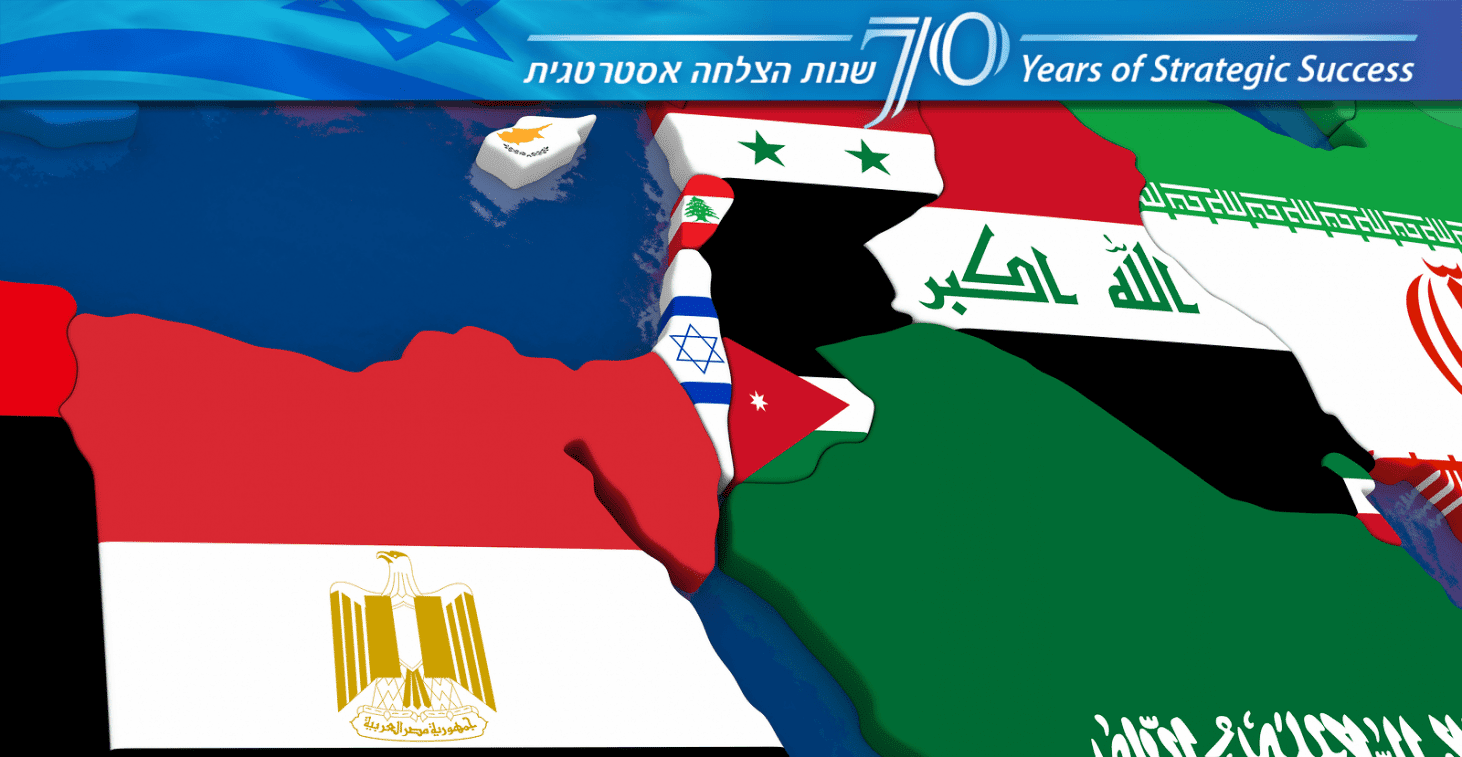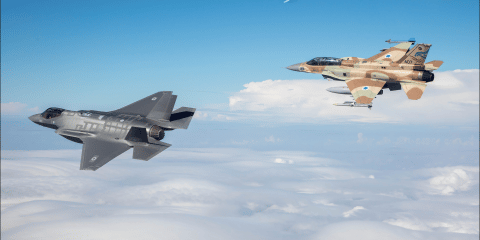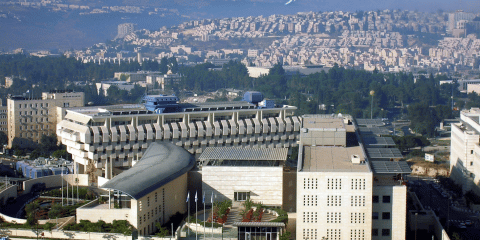None of the new threats in the region constitutes a threat to the viability or continued existence of the State of Israel. Israel at 70 appears well equipped to navigate the instabilities, and even to benefit from them in certain areas.
This is the sixth article in a special series of studies by JISS experts to mark Israel’s 70th anniversary. The series examines Israel’s diplomatic and defense achievements in grand strategic perspective.
The Middle East is currently in the midst of a process of profound change. Israel is largely a neighbor to this process, not a participant in it. Yet the changing nature of the region also impacts on Israel’s security, bringing with it the decline of old threats, the growth of new ones and also the emergence of new opportunities.
Today, the main strategic challenge facing Israel is the advance of Iran and its allies across the collapsed countries between Israel and Iran – namely Iraq, Syria and Lebanon. De facto Iranian domination of these countries by Iran brings the Revolutionary Guards Corps to Israel’s doorstep. Still, for as long as Iran remains without a nuclear capacity, this threat is not existential in nature.
Other threats include the unresolved Palestinian question, the Hamas-controlled Gaza Strip, the proliferation of Salafi terror groups around Israel’s borders and Muslim Brotherhood style Sunni political Islam. The Russian return to the region is also a challenge for Israel. But while each of these forces are consequential and some of them formidable, none constitutes a threat to the viability or continued existence of the State of Israel.

Arab Spring?
For decades following the eclipse of Arab nationalism in the 1960s, the Arabic-speaking Middle East was characterized by a kind of sclerotic stability. This old Arab order began to crumble with the US destruction of the Saddam Hussein regime in Iraq in 2003. This act, however, while altering the balance of power in the region (to the significant advantage of Iran) did not appear to presage broader changes in the Arabic speaking world. Contrary to the predictions of some western analysts, the destruction of Ba’athi Iraq did not trigger an immediate wave of popular revolts against other authoritarian regimes in the region.
This wave did come, however, beginning in Tunisia in 2010 and eventually extending to Egypt, Syria, Libya, Bahrain and Yemen.
The so-called ‘Arab Spring’, along with its knock on effects (western intervention in Libya, Syria and Iraq, Russian intervention in Syria, Turkish involvement in Syria and Iraq, Saudi and Iranian rival involvement in Yemen, the advance of Iran in Iraq and Syria) have up-ended the regional order, ending the long period of repressive stability, and replacing it with a kind of ‘war over the ruins’, as rival states and alliances compete for influence and power in the large, poorly or partially governed spaces that are the main result of the popular agitation of recent years.
These clashes are sometimes fought out through proxies (Houthis in Yemen used by Iran to apply pressure on Saudi Arabia, Lebanese Hizballah, Afghan Fatemiyun etc mobilized by Iran to defend Assad regime in Syria). On other occasions, more rarely, states have themselves sent forces into the areas of conflict, resulting in direct clashes between state armed forces (Israel against Iran in Syria), or in clashes between the armed forces of one state and the proxy organization of another (Houthis against Saudi and Emirati forces in Yemen, Turks against west-associated YPG in Syria).
For the most part, the wave of activism from below in the Arab world that commenced in 2010 is now spent. There is today no Arab country which is subject to a popular insurrection. Rather, authoritarian regimes have reasserted themselves (Egypt, to some degree Syria). Forces that emerged from the period of popular revolt and which survive today largely do so as a result of their acting as military contractors for states (see the use made by Turkey of the remnants of the Sunni Arab rebellion in northern Syria).
What remains, however, is a region in which there are large, strategically vital spaces in which no coherent governance exists. In these areas, and beyond them, a contest is taking place for supremacy between powerful regional states, and alliances of states. This new contest is currently the key strategic process taking place in the Middle East.
The alliance led by the Islamic Republic of Iran is the most organized and united force operating in this space. In Lebanon, Syria, Iraq and Yemen, Teheran now has the upper hand. The attempts by powers threatened by Iran to organize against it are not currently properly coordinated and are achieving only partial results.
Thus, the old, sclerotic Middle East of stable and repressive nationalist dictatorships has gone. To be replaced by a new, fragmented and chaotic space in which a strategic contest is under way. Israel, as a country directly threatened and indeed marked down for destruction by the Islamic Republic of Iran, has a direct interest in this contest. At the same time, looked at from a wider perspective, recent events in the region showcase the extent to which Israel’s traditional adversaries have grown weaker or been eclipsed, shortening the list of the strategic threats to the Jewish state.
Israel and the Regional Upheavals
As a neighbor but not a partner to the political and societal processes in the Arab world, Israel has found itself largely a spectator to the dramatic events of the last seven years.
This is not to say that the processes taking place just across the border were not of significance to Jerusalem. During the short period that the Muslim Brotherhood were in power in Egypt (2011-12), Israelis glimpsed the possibility of a strategic disaster – namely, the unilateral abrogation by Egypt of the 1979 peace treaty between the two countries. The military coup of July 3, 2013 ended this possibility, and was silently welcomed by Jerusalem.
To the north, the civil war in Syria has significantly reduced the conventional threat to Israel, in that the Syrian Arab Army, the conventional forces of the Assad regime, have been decimated by the war. For the most intense period of the civil war, Israel succeeded in securing its borders through de facto cooperation with rebel groups in Quneitra Province, while preserving its ability to act against Iranian weapons supplies to Hizballah from the air. With the waning of the civil war, however, this delicate balance is being brought into question. As the rebellion retreats and contracts, so the possibility of the return of the regime to the border area with the Golan Heights grows.
The dilemma for Israel with regard to this challenge neatly sums up the broader central issue facing Israel with regard to the region at the present time. On the one hand, Israel has little remaining to fear from the Assad regime, and would have no particular objection to its return to the border. Israel was never a strategic backer of the rebellion, which largely took Sunni Islamist form, and which had it been victorious would likely have produced a Sunni Islamist regime hostile to Israel.
On the other hand, while the conventional threat remaining from the Assad regime is minimal, it is precisely the weakened sovereignty of the regime which is paving the way for the new and more potent challenge – namely the advance and consolidation of the independent military infrastructure being constructed by Iran on the soil of Syria. It is this infrastructure and the intentions behind it which today constitute the most potent remaining security threat to Israel.
Thus, the old order of Arab nationalist states with their huge conventional armies and their bellicose threats against the Zionist enemy is past. These were the only force which ever posed a direct, conventional, existential threat to Israel, in the period 1948-79. Egypt, whose decision to make peace with the Jewish state effectively ended the conventional existential threat, remains under military rule but its leader cooperates closely with Israel, because of the shared agenda with regard to challenging violent Sunni political Islam. The Baath regime in Iraq no longer exists, and its sister regime in Syria is truncated, exhausted and hollowed out by seven years of war.
Israel’s victory against this first and most potent manifestation of hostility to it was not only military in nature, of course. Arab nationalist regimes were singularly unsuccessful in developing the economies, civil societies and human resources of the societies over which they ruled. The unrest of the post 2010 period was the delivering by history of its decidedly negative verdict on their project. Israel, by contrast, has grown over the same period from a developing country into an OECD member state and a world leader in a number of technical fields.
Sunni Political Islam
The unrest of the post 2010 period looked for a moment like birthing a new potent challenge in the form of a Sunni Islamist power bloc taking in Egypt and Turkey and perhaps potentially Syria, and eventually the Palestinian territories and Jordan. In the event, this notional power bloc was stillborn. The Muslim Brotherhood was deposed in Egypt. The largely Sunni Islamist Syrian rebels have been defeated.
It is important to note in this regard that the most popular political force on the ground across the Arabic speaking world remains political Islam. As and when Sunni Arabs within the fragmented spaces begin to organize and compete with the Iranians and their allies, it is thus likely that the form that their organization will take will be Sunni political Islam. But as of now, this force is not crystallized into a powerful, unified bloc.
The Palestinian Issue
Palestinian nationalism has for a decade been split into two, both organizationally and ideologically. The Gaza Strip remains under Islamist rule. Hamas is running an entity in Gaza that combines visceral hostility to Israel with weakness, relative isolation (Sisi’s Egypt is also an enemy of the Islamist rulers of Gaza) and impoverishment.
Fatah controls a de facto autonomous entity in the West Bank which combines political opposition to Israel with security cooperation with its security organs against the more urgent danger of its own Islamists.
The West Bank remains the focus area of the unresolved conflict between Israel and the Palestinians. However, in cooperation with the Israeli security forces and western and Jordanian security assistance, the Ramallah Palestinian Authority currently appears secure, and uninterested in inciting or supporting a violent campaign, despite the restrictions on its rule and the unresolved nature of the conflict.
The notion that the Palestinian challenge might come to represent an existential threat to Israel thus seems less salient today, despite the BDS movement in the west and the widespread popular opposition to Israel both across the Arab world and among left wing circles in Europe and to a lesser extent North America. These are an irritant, with the potential of becoming something more if the leftist and Islamist currents were to achieve political power. At present, this is a possibility in one major European country – the UK.
Salafis
Salafi-jihadi organizations exist in all the areas adjoining Israel – in the West Bank, Jordan, the Gaza Strip, Egypt, Lebanon and Syria. Their potency exists in direct proportion to the absence of strong central authority. Thus, in Jordan and along the Jordan Valley, because of the presence of the IDF in the latter area and the Jordanian authorities in the former, Salafi jihadi organizations remain a minor irritant. In the West Bank, due to security cooperation between Israel and the PA, the efforts of the Salafis to organize have produced only sporadic results. In Gaza, the Hamas authorities tolerate a measure of Salafi activity as a means of pressuring Israel, while firmly clamping down on any attempt by Salafi groups to assert a political challenge to Hamas rule in the Strip.
In southern Lebanon, similarly, Hizballah’s domination prevents independent activity by Salafi groups. But the Shia Islamist organization on occasion makes use of the Salafis as an additional tool of pressure on Israel.
The two areas in which the potential challenge of Salafi-jihadi groups to Israeli security is most keenly felt are in northern Sinai and in south-west Syria. These are also the ‘least governed’ spaces adjacent to Israel. In both areas, Salafi-jihadi groups affiliated with the Islamic State are active. In northern Sinai, the Wilaya al-Sina (Sinai Province) organization, formerly known as Ansar Beit al-Maqdis, is engaged in insurgency against the Egyptian authorities. Despite ongoing efforts by the Egyptian army, the group remains potent and active.
In south west Syria, the IS-affiliated Khaled ibn al-Walid Army controls a strip of territory from the town of Tasil down to the border with Jordan, which adjoins the Israeli-controlled part of the Golan Heights. The greater part of the area of Quneitra Province has been controlled by the Syrian Sunni Arab rebels since 2012. The rebels are opposed to Khaled Ibn al Walid but have proved unable to dislodge it from the area of territory it controls.
Salafi groups are politically unsophisticated and militarily primitive, at the moment constituting more of an irritant than a threat.
The Return of Russia / US Drawback
The Israeli system classifies Russia as a ‘rival’ rather than an ‘enemy’ state. However, the Russian intervention on behalf of the Assad regime in Syria after September 30, 2015 has significantly complicated Israel’s strategic situation. Russia in Syria has no hostile designs on Israel, but it is in strategic alliance with Iran in backing the Assad regime. Russian air defenses in Latakia province and covering all of Syria had and have the potential to disrupt Israeli air actions against Iran and its proxies. Largely, this has been avoided because of the de-confliction process established immediately following the Russian entry into Syria. Prime Minister Netanyahu, Chief of Staff Gadi Eizenkot and Military Intelligence Head Herzl Halevi visited Moscow immediately following the Russian intervention to set this process in motion. Nevertheless, the need to avoid potential clashes with Russia introduces a significant complicating factor for Israel in the region. Should Russia provide the S-300 air defense system to Syria this will increase the danger to Israeli pilots (though probably not in a way that would be unmanageable).
The return of Russia to the region became possible because of the vacuum resulting from the Obama Administration’s determination to draw back US commitments in the Middle East. At the time of writing, it is not yet clear the extent to which the Trump Administration intends to reverse this. From an Israeli point of view, the decline of the US-led security architecture in the region is of course as a negative. At the same time, as the strongest ‘client’ of the US in the region, Israel is also well placed to nevertheless respond to security challenges even in the context of a reduced US ‘footprint in the region.’ It is also possible that the knock on effects of the US decision to withdraw from the Iran nuclear deal will serve to draw the US back into the region as the head of a coalition in cooperation with allies seeking to contain and roll back Iranian influence in the Middle East.
The Remaining Challenge: Iran and its Allies
So the old Arab nationalist regimes are gone (Iraq), reconciled (Egypt) or weakened (Syria). The Sunni Islamist state bloc, which seemed set to replace them, has not emerged. Palestinian nationalism is split and weakened. Salafi Jihadi Islamism remains a minor terrorist threat, not a political or military challenge.
This means that the only real and pressing (though also not existential, for as long as Iran remains non-nuclear) strategic challenge to Israel today is the Iran-led regional bloc, which as noted above today controls Lebanon, and is increasingly dominant in Syria and Iraq.
So what are the implications for Israel of the growing Iranian challenge, and of the emergence of the Iranian drive for dominance in the fragmented spaces of the region as the primary strategic process in the region?
First of all, it should be noted that not all the implications are negative. If the renewed cooperation with Egypt derives from a common opposition to Sunni political Islam, joint opposition to Iran is bringing Israel and the key states of the Gulf – Saudi Arabia and United Arab Emirates – into a common strategic space. The emergence of Crown Prince Mohamed Bin Salman of Saudi Arabia as the key driving force in that country is bringing this reality increasingly into the open. ‘MBS’s much reported impatience with the Palestinians, and his statements confirming Jewish rights in Israel represent a revolutionary departure in the language emerging from the royal court in Riyadh.
The Crown Prince’s determination to wean Saudi Arabia away from dependence on hydrocarbons creates a natural deeper context for improved overt relations with Israel, though it is probable that these will not emerge without some diplomatic progress with the Palestinian Authority. Behind the scenes cooperation, however, in both security and private sector fields is likely to continue. Mohammed Bin-Zayed of Abu Dhabi, meanwhile, is playing a similar though less visible role in the UAE. His staunch opposition to Iran and to the Muslim Brotherhood similarly makes him a natural partner for Israel on the regional stage, despite the sensitivities about open declarations in this regard.
However, the challenge remains a serious one. Iran is the main force behind Palestinian Islamic Jihad, and an important contributor and enabler of Hamas. Iran of course created and armed Hizballah, the most powerful paramilitary enemy faced by Israel at the present time. And in Syria, as a result of its vital contribution to the survival of the Assad regime, Iran is currently in the process of constructing an independent military infrastructure intended to be directed against Israel.
Thanks to the prominent role played by its proxies in defending Iraq against ISIS, and the consequent establishment of a permanent Shia militia army in Iraq, as well as the role of its proxies in government, the IRGC can now operate freely in Iraq. What this means is that a contiguous line of control stretching from Teheran to southern Syria now exists. An at the point of the arrow, in Syria, Iran is engaged in constructing permanent bases for the storage of missiles and UAVs and the training and administration of personnel, is basing around 20,000 members of proxy military organizations, and is engaged in recruiting locals for such prototype Syrian ‘Hizballah-type’ militia organizations as Quwaat al-Ridha and Al Ghalibun. This process, with the Iranian nuclear ambition behind it, is intended to be directed against Israel in a long war of attrition to end in the Jewish state’s destruction, as endlessly repeated by Iranian spokespeople.
This aim was exemplified in an April 19 speech by General Hossein Salami, vice commander of the IRGC, who said that “(Israel’s) soldiers and civilians will flee, and you won’t survive. And you’ll have nowhere to run, except to fall into the sea.”
Thus the combination of politicidal intent, the power of a state (Iran), and the proven effectiveness of the IRGC’s methods of proxy building and mobilization of political-military groups, combine to constitute today the main strategic threat to the State of Israel, against a more general picture of declining threats.
Conclusion
At 70, Israel finds itself in a position of having outlasted and out-developed the main trends which sought its destruction – Arab nationalism in the 1948-73 period, and Sunni political Islam from the 1970s until today. Both these trends manifest themselves in the Palestinian national movement, which is today divided between nationalists and Islamists. Palestinian nationalism retains high visibility and popularity in the Arab and Muslim worlds, and among the left in western Europe and North America. But the recent upheavals in the Arab world have served to place the Palestinian issue within a larger context of regional dysfunctionality, and the emergent struggle between Iran’s desire for regional hegemony and the forces opposed to it have ended its perceived centrality. The now apparently semi-permanent division of the Palestinian movement into two rival camps – nationalist and Islamist – and the de facto dependence of the former camp on the west and Israel for its survival, further reduce the Palestinian strategic threat.
As detailed above, the main strategic threat against Israel today is thus represented by the Islamic Republic of Iran and the largely Shia Islamist camp it leads. As a result of the fragmentation of Iraq and Syria, this element is now in effective control of a contiguous line of territory stretching from Iran almost to the borders with Israel. This constitutes a danger to the security of Israel’s citizens, but at present is not an existential threat to the state’s survival. The return of Russia to the Middle East further complicates the picture. But while there are many factors suggesting heightened instability in the period opening up in the Middle East, Israel at 70 appears well equipped for navigating this instability, and even benefiting from it in certain areas.
photo: Bigstock









 - בניית אתרים
- בניית אתרים